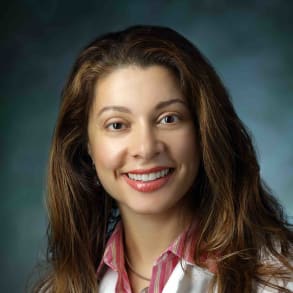Geriatrician Alicia Arbaje discusses research on the role of culture in transitions of care and how health care systems can be made safer by understanding the experience of older adults.
Hello, I'm Alicia Arba. Hey, I'm a geriatrician and health services researcher in the division of Geriatric Medicine and Gerontology at Johns Hopkins University School of Medicine. I'm the director of transitional care research, which means that I focus on how to help older adults navigate the complicated health care system that we all live and work in. And I helped look to make it safer for older people to navigate from the hospital to home and receive care in the home environment. And I'm really passionate about these areas first, because I grew up in rural Kansas where there weren't a lot of health care services nearby. My grandmother needed to go to the hospital quite a bit. Towards the end of her life, I wanted to become the kind of doctor that could help families navigate these complicated transitions. When she would come home, we would have tons of questions. She didn't speak the language because she was from another country, and the whole cultural piece was also really important. So I became the kind of Jerry attrition that helps people with these decisions and that helps families make complicated decisions and understand what I have become. Now to learn in my research, which is that all transitions are cultural transitions as well. They're cross cultural transitions, meaning it's a whole different world in the hospital and the whole different world in the skilled nursing facility and a whole different world at home. And part of what we do in geriatrics here at Johns Hopkins is to bridge those different worlds on to help people really navigate that with dignity and respect, and really understanding and feeling empowered to manage their conditions. So some of the research that we do that I think, is really exciting in the spaces I work in the hospital setting. My research is all in the home setting. So I have a team of researchers, and we go out into people's homes to understand older adults experiences when they first come home from the hospital. What was the culture like when they left? And what is it like now in the home? What are the family dynamics? What are the ways that people decide who does what health care task when older people get home? How does the transition evolve over time? And these are questions we ask, and I'm especially interested in understanding how we can help make health care safer for people. How can we respect their cultural differences on drily, help them feel empowered? They study Latinos who have come home who are living with dementia, older adults who have just been in the hospital or a skilled nursing facility and really take photos of their home environment. Take videos, interview family members and interview. Very importantly, the home health care providers who are coming in to be the eyes and ears of those of us who work outside of the home setting. And it's just really exciting because I have really gotten the chance to immerse myself in the world of home health nurses, home health, physical and occupational therapists, home health aides and all these other professions that are really so vital and critical to helping people stay independent at home with the dignity that they deserve. I'm really excited about all the work that we're doing. It's the goal of it all, is really to develop ways to redesign the health care system, to make health care safer and of higher quality for older adults and what we hope all this research will lead Thio, our new methods to measure quality, UM, and care transition quality in particular, so that health systems can understand in real time when transitions are going well and when care transitions are not going well and so that they can act before harm can occur. And really, our goal is to bring the patient and family voice into research and into the measurement of care, transition quality so people can tell us in real time how things are going for them, and we can also act. So this is very exciting because we think it will help bring patient and family voices into riel time assessments of care, transition, quality. And we can develop dashboards and other methods of disseminating two health care institutions how they can monitor their transitions in real time and help older adults thrive when they get home.



